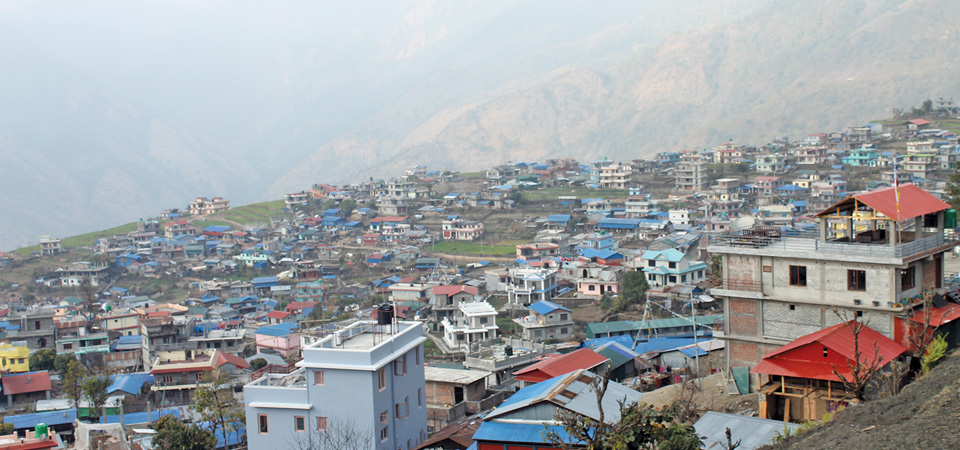Barpak with concrete houses no more a pristine village

By Narendra Dhakal
Gorkha, Feb. 23: It has been seven years since the 2015 earthquake. Many houses that collapsed during the tremor have been rebuilt. Multi-storeyed buildings stand in places where once huts stood and in these buildings are banks, offices and business complexes. Narrow alleys have been replaced by paved wide roads and along these roads, health and education institutions have popped up. The 7.8 magnitude quake has transformed its epicentre Barpak beyond recognition.
The settlement, located at an altitude of 1,800 to 1,900 feet above sea level, now also has access to drinking water and waste management and has been connected to the road network and the national grid. Satya Narayan Shah, in-charge of the Manaslu Conservation Area Project, summed it up perfectly: “Barpak is no longer a village. It is now a city in the foothill of the Himalayas."
But its residents are not happy about this change. “We have lost the Barpak we knew and loved,” local Kali Ghale said. “It’s not pleasing to the senses.”
A total of 1,301 houses in wards 1 and 2 of Barpak Sulikot Rural Municipality that the 2015 quake had razed have been rebuilt with concrete and steel. “But cemented houses are cold and totally unsuitable to our mountainous climate,” another local Man Bahadur Gurung said, lamenting his choice of constructing a so-called modern house. “The stone and mud houses kept us insulated and sheltered from the elements. That is not the case with the newer structures.”
Gurung also opined that the old houses were a part of Barpak’s identity and culture. “While we rebuilt our individual houses, we failed to revive the soul of our community.”
Resident Laljeet Ghale also had this belief. “Before the earthquake, we had rows and rows of beautiful stone houses that gave Barpak a unique look and feel. Scores of people used to come here every week to see the village.”
The people that Ghale is talking about still come but what they see leaves them disappointed. “It has become like Kathmandu,” said Samrat Paneru, who came to Barpak this week from the capital. “Why would we come to Barpak to see tall cemented buildings that we see every day in the city?”
Suk Bahadur BK feared that Barpak would soon suffer under the haphazard urbanisation it was currently undergoing. “Ours was a model village before the earthquake but I am afraid at the direction we are taking now.”
Experts, including Shah, do not share the natives’ view and believe that Barpak should be allowed to urbanise. However, they stress the need to plan this urbanisation and make Barpak a smart city.
“People have invested a huge amount of money to build the current structures so we should not talk about demolishing it and going back to how things were before,” Shah said. “Instead, the relevant authorities should focus on managing sewage, water and other facilities.”
Recent News

Do not make expressions casting dout on election: EC
14 Apr, 2022
CM Bhatta says may New Year 2079 BS inspire positive thinking
14 Apr, 2022
Three new cases, 44 recoveries in 24 hours
14 Apr, 2022
689 climbers of 84 teams so far acquire permits for climbing various peaks this spring season
14 Apr, 2022
How the rising cost of living crisis is impacting Nepal
14 Apr, 2022
US military confirms an interstellar meteor collided with Earth
14 Apr, 2022
Valneva Covid vaccine approved for use in UK
14 Apr, 2022
Chair Prachanda highlights need of unity among Maoist, Communist forces
14 Apr, 2022
Ranbir Kapoor and Alia Bhatt: Bollywood toasts star couple on wedding
14 Apr, 2022
President Bhandari confers decorations (Photo Feature)
14 Apr, 2022











